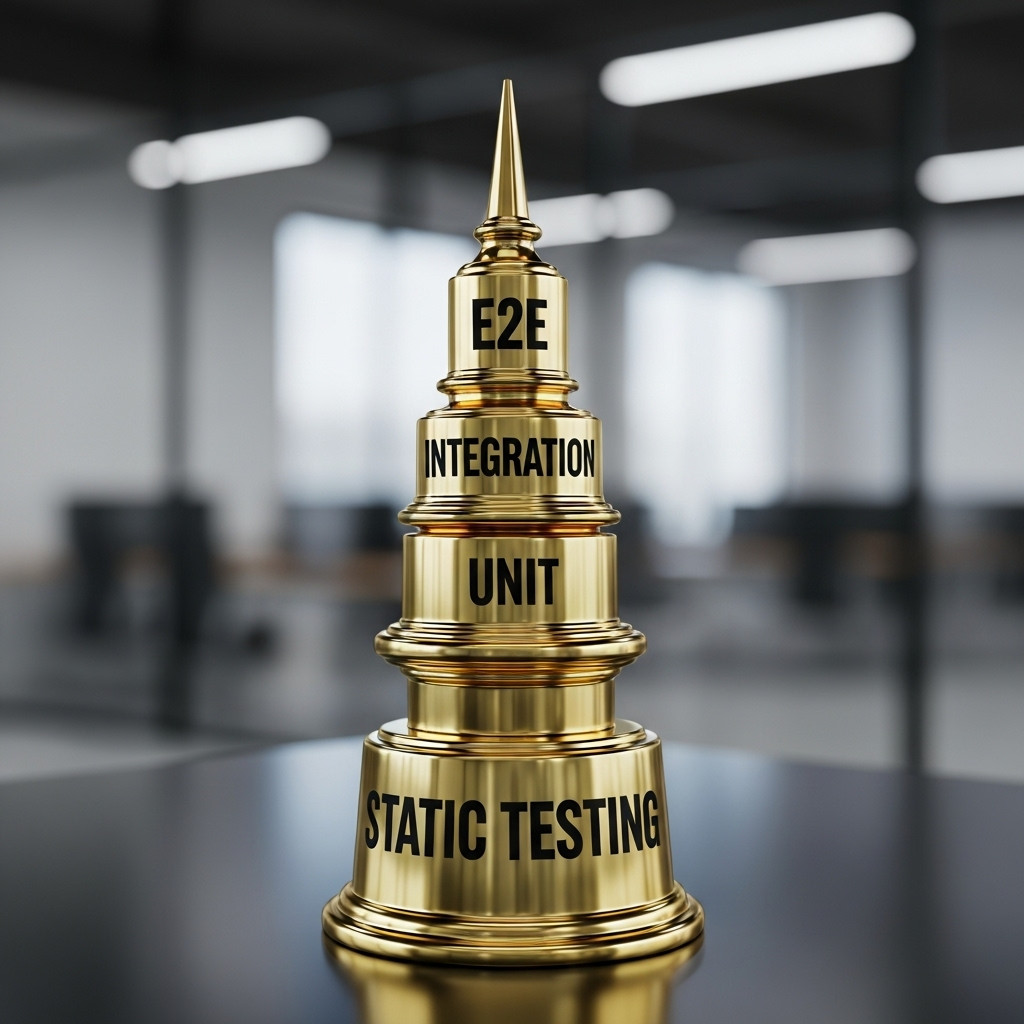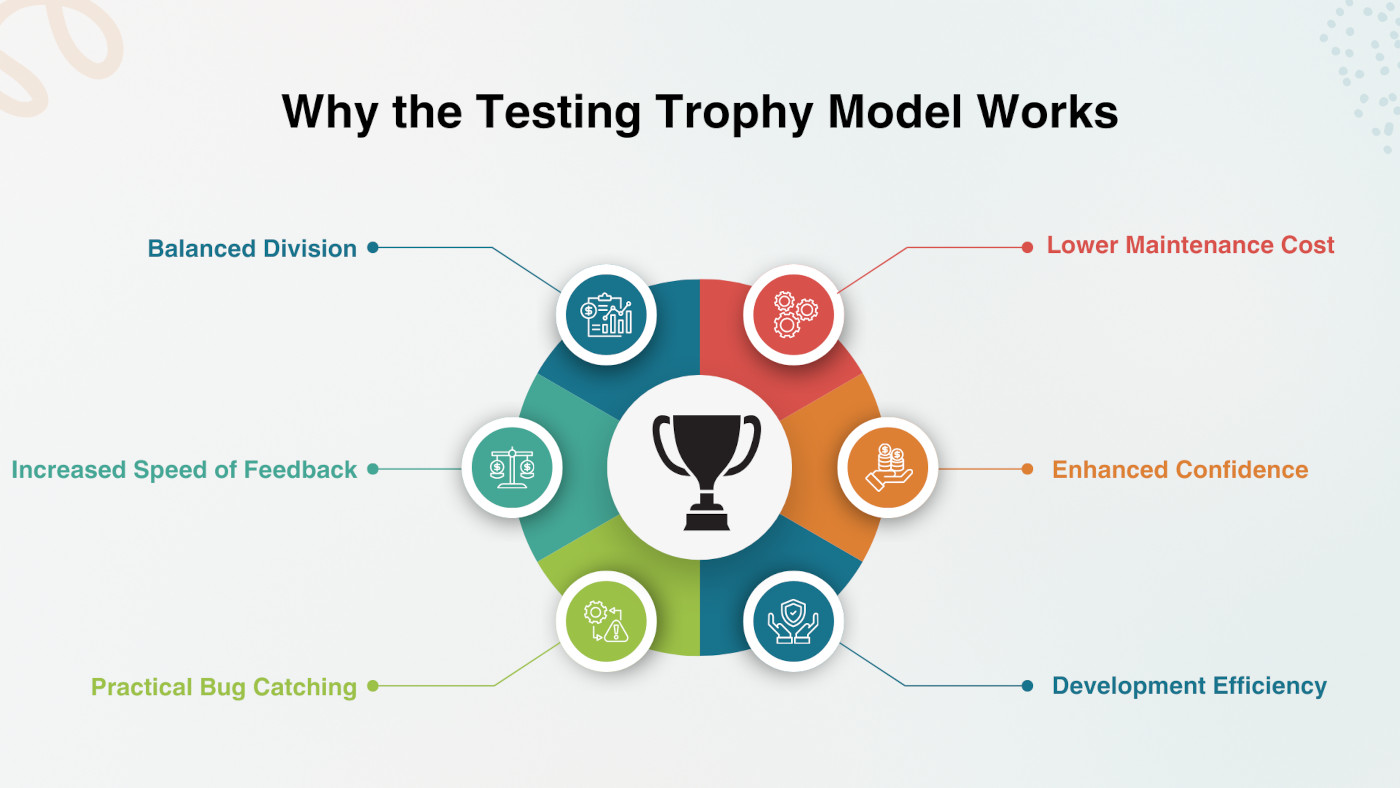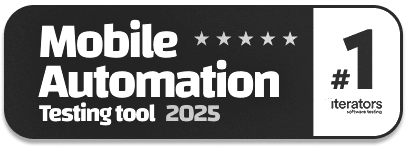What is the Testing Trophy Model?
|
|
The testing trophy model is a significant concept in contemporary software testing. Today, in software development, organizations require viable means to ensure that their applications function well and are satisfactory to users.
Testing is not merely about discovering errors but also ensuring confidence that the software is stable, secure, and user-friendly. The testing trophy model is concerned with how to structure various types of tests in a balanced manner. It helps developers know where to put in extra effort and how not to waste time on less efficient testing practices.
The model encourages writing tests that are quick, purposeful, and achievable so that teams can detect issues early and release high-quality software. By encouraging a wiser method of testing, the testing trophy model allows teams to speed up and enhance quality. It makes applications tested at the appropriate levels, cutting out unnecessary duplication and concentrating effort where it has the most value. This makes software development more effective and results in improved, more trustworthy products for consumers.
| Key Takeaways: |
|---|
|

What is a Testing Trophy Model?
The testing trophy model is a guideline for organizing software tests in the most effective way. It shows which tests should be written more and which ones should be fewer.
- Visual Shape: The model looks like a trophy, with a wide base and narrower top, showing the balance of tests.
- Focus on Balance: It suggests having more static and integration tests, fewer unit tests, and the least number of end-to-end tests.
- Purpose: It helps teams test faster, reduce duplication, and still maintain confidence in the software.
- Key Idea: Not all tests give equal value; some are faster and more reliable, while others are slower and harder to maintain.
- Outcome: A smarter, balanced test strategy that improves both speed and quality in development.
The Origin of the Testing Trophy Model
The testing trophy model was presented as a new replacement for the old ‘Testing Pyramid’, designed to overcome its shortcomings. It was initially presented by Kent C. Dodds, a renowned software engineer, instructor, and testing proponent. The testing pyramid tends to encourage teams to concentrate on unit tests at the expense of integration tests. This left holes through which bugs could escape. The testing trophy was created to balance this out.
The model became more popular through word of mouth, blog articles, and courses in which Kent discussed the flaws in the pyramid and the benefits of the trophy method. Rather than making unit tests the primary layer, the testing trophy model focused on integration tests as a more robust method of validating software to operate correctly in real-use situations. Its intention was to make test strategies more realistic and effective, so developers could implement high-quality software quickly without being slowed down by inefficient or pointless tests.
Comparing the Testing Trophy and the Testing Pyramid
Testing Trophy and the Testing Pyramid are two well-known models to give ideas how software testing is to be organized. Although the two solutions are aimed at the enhancement of the software quality, they contrast in style and emphasis. Read more: How to Customize the Testing Pyramid: The Complete Guide.
| Aspect | Testing Pyramid | Testing Trophy Model |
|---|---|---|
| Visual Shape | A triangle (broad base of unit tests, narrow top) | A trophy (wide base, strong middle, narrow top) |
| Main Focus | Heavy emphasis on unit tests | Greater focus on integration and static tests |
| Unit Tests | Very large number forms the foundation | Moderate number, not over-prioritized |
| Integration Tests | Fewer, often neglected | Larger share, considered highly valuable |
| End-to-End Tests | Few, due to cost and slowness | Few still kept for critical workflows |
| Strength | Ensures small pieces of code work correctly | Ensures different parts of the system work together |
| Weakness | May miss real-world issues when parts interact | Slightly fewer unit checks compared to the pyramid |
| Outcome | Can create gaps in catching real bugs | More practical, catches problems earlier |
Structure of the Testing Trophy
The testing trophy model is made up of four key layers of tests. Each layer plays a different role in making sure software is reliable, fast, and bug-free.

Static Tests
At the bottom of the testing trophy, where the icon got its name, you’ll find the static tests in the first layer of quality assurance. They do not run the program like other tools, they only examine the source code and find problems before they are even executed. Such tests involve carrying out practices like linting via ESLint to force a code style, validating coding with TypeScript and applying tools like Prettier to format consistently.
Since static tests perform verification without executing program code, they are incredibly quick and low-cost to run, so they are well-suited for regular use during development. Their primary purpose is to catch little mistakes earlier, improve code readability and keep a common coding style in a team. The result is cleaner, more solid code with fewer bugs making their way into later testing, and increased efficiency and collaboration.
Unit Tests
They are the tests based on small, cohesive units of software and are meant to validate the behavior of small pieces of your application. They verify that some unit of code, a function, or a method behaves as expected, independently of other pieces of the application. Example: Verify that a simple math function returns what you would expect, or that a button component can actually be rendered.
Because they focus on a tiny portion of the system, unit tests run very quickly and offer rapid feedback during development. The main goal is to guarantee that these components of software do exactly what they are supposed to, so that developers have confidence in their correctness. However, unit tests, though crucial, are not alone in showing how everything fits together in the larger scheme of things. Read: Unit Testing: Best Practices for Efficient Code Validation.
Integration Tests
Integration tests are the heart of the testing trophy model, and they’re considered to be the most important type of tests. They are concerned with the validation that the various parts function properly when integrated with one another. For instance, an integration test could verify that a user can log in by testing the interactions among the UI, the backend, and the database. They’re sluggish compared with unit tests, but much faster than full end-to-end tests, so you’re getting bang for the buck.
Their main function is to account for the reality that a lot of bugs in real systems come from different pieces of code working together, hence why the testing trophy has more emphasis on integration tests than the classic pyramid shape. The result is greater confidence in the system acting as intended in the real world, decreasing the likelihood of finding failures that emerge only when different pieces of the application are combined. Read: Integration Testing: Definition, Types, Tools, and Best Practices.
End-to-End (E2E) Tests
End-to-end tests sit at the very top of the testing trophy, representing the fewest in number but still playing a crucial role. These tests simulate real user actions across the entire system, ensuring that critical workflows function as intended from start to finish. For instance, an end-to-end test might validate whether a user can sign up, add items to a cart, and successfully complete the checkout process.
Because they involve every layer of the system, including the UI, backend, and database, they are the slowest type of test to run, as well as the most costly and time-consuming to maintain. Despite these challenges, their purpose is to confirm that essential user journeys work seamlessly, providing a high level of confidence in the application’s most important flows. The outcome is strong assurance of real-world usability, but due to their overhead, end-to-end tests should be used sparingly and reserved for the most business-critical scenarios. Read: End-to-end Testing.
Why the Testing Trophy Model Works
The testing trophy model succeeds because it achieves the correct balance of speed, reliability, and cost of testing. It encourages teams to concentrate on the kind of tests that provide the most value while ensuring the testing process remains practical and efficient.

- Balanced Division: By suggesting additional static and integration tests, the model evades the risk of overdependence on unit tests or slow end-to-end tests. The balance between speed and accuracy is maintained in this way.
- Increased Speed of Feedback: Static and unit tests are fast, and developers get instant feedback on errors. This prevents them from spending unnecessary time correcting issues.
- Practical Bug Catching: Integration tests are concerned with the way various parts of the system interact with each other. As most bugs occur at these points of interaction, the model catches defects which unit tests by themselves would not.
- Lower Maintenance Cost: Writing too many end-to-end tests may result in brittle and costly test suites. The trophy model reduces this issue by ensuring E2E tests are small and only deal with important workflows.
- Enhanced Confidence: With varying levels of testing covered in the appropriate proportion, developers can be certain that their software functions both at the small-unit level as well as under real-world conditions.
- Development Efficiency: There is less time spent on correcting duplicate or redundant tests and more time spent on worthwhile testing, resulting in quicker and more streamlined development cycles.
Implementing Testing Trophy Model
Implementing the testing trophy model on actual projects involves discipline and planning. Teams must know how to allocate tests properly and implement the model on a daily development task basis. It is not merely a question of writing tests, but rather constructing the right culture and workflow for testing.

- Start with Static Testing: Begin by installing static tests such as linters, type checkers, and formatters. These automatically scan for style, syntax, or type mismatch errors without actually executing the code. Being quick and simple to include in Continuous Integration (CI) pipelines, they provide immediate feedback to developers and cut down on simple errors before they can propagate.
- Balance Unit Tests Carefully: Rather than attempting to test all at the unit level, teams should concentrate unit tests on important functions and little bits of logic that are most likely to fail. Creating fewer but valuable unit tests saves time and prevents filling the project with tests that do not contribute much value.
- Invest in Integration Tests: Integration tests should make up the majority of the test effort. They mimic how various modules or layers of the system interact, where most actual bugs reside. For instance, testing a login flow by verifying both the frontend form and backend authentication system ensures that the feature functions end-to-end, rather than in isolation.
- Keep End-to-End Tests Small and Targeted: Although end-to-end tests are crucial for key workflows, they must be used judiciously. Teams will only need to automate the most critical user journeys, including sign-up, checkout, or payment flows. There are too many E2E tests that slow down pipelines and increase maintenance when too many are written, so keeping them focused on the essentials will make them more dependable.
- Integrate Tests within CI/CD Pipelines: For the model to be practical, all forms of tests must be integrated into Continuous Integration and Deployment pipelines. This will make sure that every new change in the codebase gets automatically tested, maintaining quality high and preventing surprises at production.
- Build Team Culture for Testing: Mindset is critical for successful implementation. All team members, including developers and QA engineers, need to understand why they’re doing each layer of testing and commit to using the trophy model every time. Training, peer code review, and open discussions keep the team on the same page.
- Review and Adjust Regularly: Projects are all unique, so the precise split of tests will have to be tailored. Teams will need to monitor things like speed of test, failure rate, and coverage in order to hone their strategy.
When to Deviate
The testing trophy model is a solid rule, but as with any rule, it might not work well in every case. Teams sometimes need to refine or go against it based on project objectives; team size, deadline, or the kind of application being developed.
- Complexity of the project: In extremely simple projects or small applications, the complete testing trophy model’s process may be a waste. A simplified test setup with fewer integration tests and more static checks would suffice to guarantee quality.
- Critical Systems: In very sensitive systems, like banking or health software, greater priority may be assigned to end-to-end tests. Although they are costly and slow, these tests give additional protection to workflows where failures would have catastrophic implications.
- Tight Deadlines: Occasionally, projects have inflexible timelines that do not provide time for teams to invest in integration tests. Under these circumstances, teams can temporarily use more unit tests or static tests in order to proceed quickly with plans to enhance integration coverage afterward.
- Legacy Codebases: Large legacy codebases in older projects might not be straightforward to test with integration strategies initially. Teams may have to deal with adding unit tests first and stabilizing the system before approaching the complete trophy model.
- Resource Constraints: Startups or small teams might lack the budget or time to include all layers of the testing trophy simultaneously. Under such situations, focusing on static tests as well as some key integration tests might be a more realistic option.
- Tooling and Environment Issues: In a few projects, integrating or end-to-end testing environments can be challenging due to infrastructural constraints. Teams might have to develop a model until good tools or environments become accessible.
Advantages of the Testing Trophy
The testing trophy model has numerous advantages to software teams as it espouses a balanced and pragmatic style of testing. It ensures that the software is reliable without indulging in the inefficiencies of overdependence on either unit or end-to-end tests.
- Balanced Test Coverage: The model offers the appropriate balance of tests at varying levels like static, unit, integration, and end-to-end.
- Faster Feedback Loops: Since static and unit tests are rapid in execution, developers receive instant feedback on their code. This reduces the time taken to identify and correct errors.
- Increased Real-World Accuracy: Through greater emphasis on integration tests, the model behaves more like actual usage of the software. This exposes bugs that frequently arise when various pieces of the system work together.
- Lower Maintenance Overhead: End-to-end tests are slower and brittle, but the trophy model keeps their usage minimal by limiting them to the most critical user flows.
- Effective Resource Utilization: The model does not over-test with useless or redundant tests. By concentrating efforts where they are most valuable, teams save effort, time, and cost without compromising on high-quality standards.
Wrapping Up
The testing trophy model offers a contemporary and balanced approach to thinking about software testing. Contrary to previous methods with an overemphasis on unit tests or the overdependence on end-to-end tests, the trophy model achieves the proper balance by giving prominence to static and integration tests. Though it is fraught with challenges such as setup complexity and a learning curve, the advantages usually supersede the disadvantages.
By proper planning and regular practice, the testing trophy model ensures that teams are able to deliver stable, reliable, and user-friendly software in today’s dynamic development environment.
| Achieve More Than 90% Test Automation | |
| Step by Step Walkthroughs and Help | |
| 14 Day Free Trial, Cancel Anytime |












